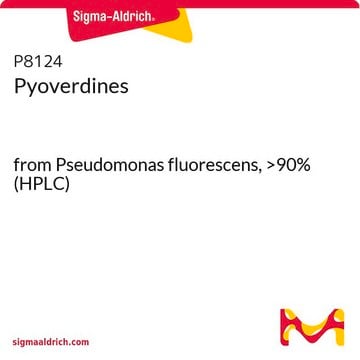所有图片(1)
About This Item
经验公式(希尔记法):
C16H21NO2
CAS号:
分子量:
259.34
MDL號碼:
分類程式碼代碼:
12352005
PubChem物質ID:
NACRES:
NA.25
推荐产品
化驗
≥96.0% (HPLC)
形狀
powder
儲存溫度
−20°C
SMILES 字串
CCCCCCCC1=C(O)C(=O)c2ccccc2N1
InChI
1S/C16H21NO2/c1-2-3-4-5-6-11-14-16(19)15(18)12-9-7-8-10-13(12)17-14/h7-10,19H,2-6,11H2,1H3,(H,17,18)
InChI 密鑰
CEIUIHOQDSVZJQ-UHFFFAOYSA-N
一般說明
2-庚基-3-羟基-4-喹诺酮可作为细胞间信号发挥作用。
應用
群体感应是细菌根据其种群密度来协调活动的信号系统。该系统涉及细菌之间通过细胞受体交换信号分子。庚基-3-羟基-4 (1H)-喹诺酮 (PQS) 是一种群体感应调控的毒力因子,用于诱导和研究铁清除相关等毒力基因的调控。
包裝
无底玻璃瓶。内容物在插入的熔锥内。
危險聲明
危險分類
Aquatic Chronic 4
儲存類別代碼
11 - Combustible Solids
水污染物質分類(WGK)
WGK 3
閃點(°F)
Not applicable
閃點(°C)
Not applicable
其他客户在看
Jintae Lee et al.
Microbial biotechnology, 2(1), 75-90 (2009-01-01)
Indole is an extracellular biofilm signal for Escherichia coli, and many bacterial oxygenases readily convert indole to various oxidized compounds including 7-hydroxyindole (7HI). Here we investigate the impact of indole and 7HI on Pseudomonas aeruginosa PAO1 virulence and quorum sensing
Doreen S W Hooi et al.
Infection and immunity, 72(11), 6463-6470 (2004-10-27)
Pseudomonas aeruginosa releases a spectrum of well-regulated virulence factors, controlled by intercellular communication (quorum sensing) and mediated through the production of small diffusible quorum-sensing signal molecules (QSSM). We hypothesize that QSSM may in fact serve a dual purpose, also allowing
Jin-Hyung Lee et al.
FEMS microbiology letters, 329(1), 36-44 (2012-01-19)
The emergence of antibiotic resistance has necessitated new therapeutic approaches for combating persistent bacterial infection. An alternative approach is regulation of bacterial virulence instead of growth suppression, which can readily lead to drug resistance. The virulence of the opportunistic human
Monique Donnert et al.
PLoS pathogens, 16(12), e1009126-e1009126 (2020-12-23)
Embedded in an extracellular matrix, biofilm-residing bacteria are protected from diverse physicochemical insults. In accordance, in the human host the general recalcitrance of biofilm-grown bacteria hinders successful eradication of chronic, biofilm-associated infections. In this study, we demonstrate that upon addition
Stephen P Diggle et al.
Chemistry & biology, 14(1), 87-96 (2007-01-27)
Pseudomonas aeruginosa produces 2-heptyl-3-hydroxy-4(1H)-quinolone (PQS), a quorum-sensing (QS) signal that regulates numerous virulence genes including those involved in iron scavenging. Biophysical analysis revealed that 2-alkyl-3-hydroxy-4-quinolones form complexes with iron(III) at physiological pH. The overall stability constant of 2-methyl-3-hydroxy-4-quinolone iron(III) complex
我们的科学家团队拥有各种研究领域经验,包括生命科学、材料科学、化学合成、色谱、分析及许多其他领域.
联系技术服务部门












